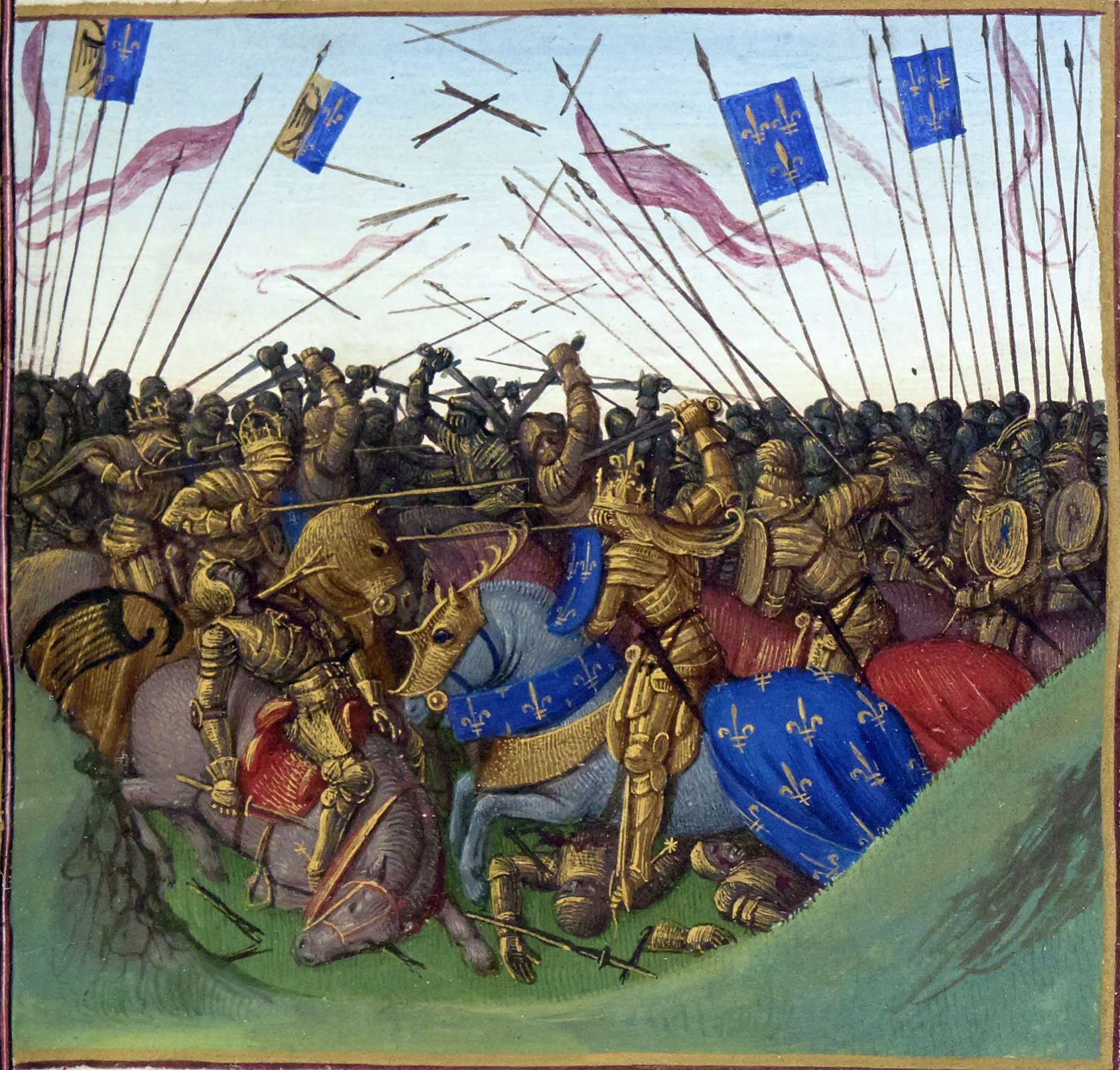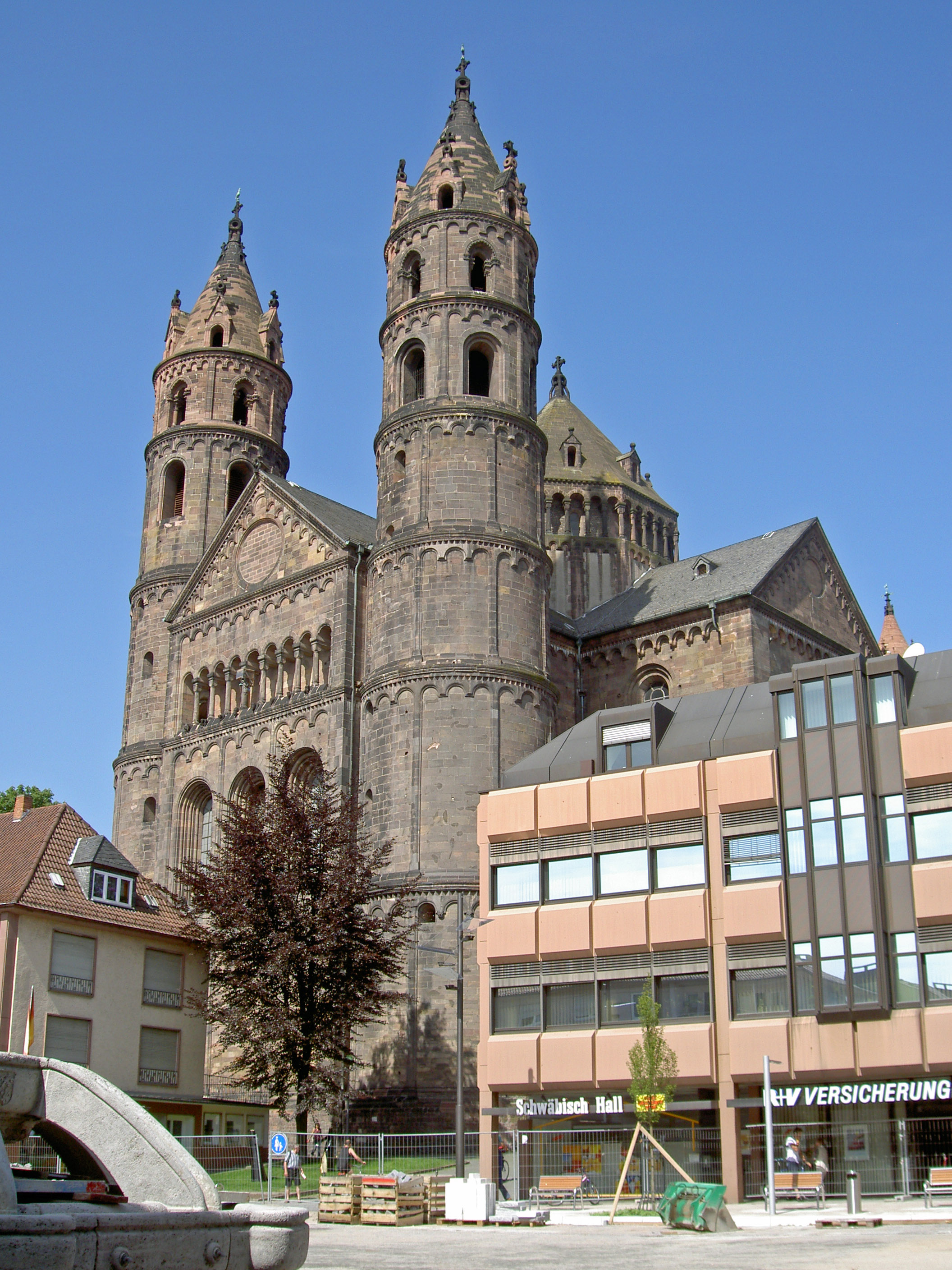|
Battle Of Fontenoy (841)
The three-year Carolingian Civil War culminated in the decisive Battle of Fontenoy, also called the Battle of Fontenoy-en-Puisaye, fought at Fontenoy, near Auxerre, on 25 June 841. The war was fought to decide the territorial inheritances of Charlemagne's grandsonsthe division of the Carolingian Empire among the three surviving sons of Louis the Pious. Despite Louis' provisions for succession, war broke out between his sons and nephews. The battle has been described as a major defeat for the allied forces of Lothair I of Italy and Pepin II of Aquitaine, and a victory for Charles the Bald and Louis the German. Hostilities dragged on for another two years until the Treaty of Verdun, which had a major influence on subsequent European history. Although the battle is known to have been large, it was not well documented. Many historical sources are believed to have been destroyed after the war, leaving scant records from which to conjecture the numbers of combatants and casualties. ... [...More Info...] [...Related Items...] OR: [Wikipedia] [Google] [Baidu] [Amazon] |
Carolingian Civil War
The Carolingian civil war was a violent crisis over the succession to the Carolingian Empire following the death of Emperor Louis the Pious in June 840 and lasting until the Treaty of Verdun in August 843. Louis's eldest son, the emperor Lothar I, laid claim to an undivided empire, while his younger brothers Louis the German and Charles the Bald sought large kingdoms of their own on the basis of previous divisions planned by the late emperor. Their nephew, Pippin II, laid claim to Aquitaine. After Louis the Pious's death, Lothar moved immediately to disregard the division of the empire and secure for himself his father's imperial position. He reached out to Pippin in Aquitaine for support against Charles. Not content with Bavaria alone, Louis the German occupied the Rhineland laying claim to all of Germania. The first military move of the budding civil war was Lothar's campaign that forced Louis from the Rhineland in August. It increased Lothar's prestige in the east, but ended in ... [...More Info...] [...Related Items...] OR: [Wikipedia] [Google] [Baidu] [Amazon] |
Worms, Germany
Worms (; ) is a city in Rhineland-Palatinate, Germany, situated on the Upper Rhine about south-southwest of Frankfurt, Frankfurt am Main. It had about 84,646 inhabitants . A pre-Roman foundation, Worms is one of the oldest cities in northern Europe. It was the capital of the Kingdom of the Burgundians in the early fifth century, hence is the scene of the medieval legends referring to this period, notably the first part of the ''Nibelungenlied''. Worms has been a Roman Catholic Prince-Bishopric of Worms, bishopric since at least 614, and was an important Count palatine, palatinate of Charlemagne. Worms Cathedral is one of the imperial cathedrals and among the finest examples of Romanesque architecture in Germany. Worms prospered in the High Middle Ages as an imperial free city. Among more than a hundred imperial Diet (assembly), diets held at Worms, the Diet of 1521 (commonly known as Diet of Worms, ''the'' Diet of Worms) ended with the Edict of Worms, in which Martin Luther wa ... [...More Info...] [...Related Items...] OR: [Wikipedia] [Google] [Baidu] [Amazon] |
Girart De Roussillon
Girart de Roussillon, also called ''Girard'', ''Gérard II'', ''Gyrart de Vienne,'' and ''Girart de Fraite'', (c. 810–877/879?) was a Frankish Burgundian leader who became Count of Paris in 837, and embraced the cause of Lothair I against Charles the Bald. He was a son of Leuthard I, Count of Fézensac and Paris, and his wife Grimildis. Girart is not described as being from Roussillon in authentic historical sources. The placename in his title is derived from a castle he built on Mont Lassois, near Vix and Châtillon-sur-Seine (Côte-d'Or). Girart de Roussillon is also an epic figure in the cycle of Carolingian romances, collectively known as the ''Matter of France.'' In the genealogy of the cycle's legendary heroes, Girart is a son of Doon de Mayence and appears in various irreconcilable events. Biography Girart fought at the Battle of Fontenay in 841, and followed Lothair I to Aix-en-Provence. In 843, Girart married Bertha. They had two children: Thierry and Ava. In ... [...More Info...] [...Related Items...] OR: [Wikipedia] [Google] [Baidu] [Amazon] |
Aubert Of Avallon
This surname has Anglo-Saxon pre-8th century origins; spelling variations include Albert, Albertson and Alberts in English names. It is derived from the Old German compound 'Aedelbeort' meaning 'noble-bright'. However, many sources show it as a French surname, with many spelling variations on the French form. It is now found in many locations of the world, spread by French Huguenot refugees, amongst others. Notable people with this surname include the following: * Abbé Aubert (1731–1814), French playwright, poet and journalist * Louis Aubert (painter) (1720 – ), painter and composer * Alexander Aubert (1730–1805), English merchant * Alvin Aubert (1930–2014), American poet * Anaïs Aubert, known as Mademoiselle Anaïs (1802–1871), French actress * Andreas Aubert (art historian) (1851–1913), Norwegian art historian * Aristide Aubert Du Petit Thouars (1760–1798), French naval officer * Arnaud Aubert (1319–1371), Catholic Chamberlain * Étienne Aubert (1282–136 ... [...More Info...] [...Related Items...] OR: [Wikipedia] [Google] [Baidu] [Amazon] |
Guerin, Duke Of Provence
Guerin, Garin, Warin, or Werner ( or ''Guarnarius''; died 845 or 856) was the Count of Auvergne, Chalon, Mâcon, Autun, Arles and Duke of Provence, Burgundy, and Toulouse. Guerin established the region against the Saracens from a base of Marseille and fortified Chalon-sur-Saône (834). He took part in many campaigns during the civil wars that marked the reign of Louis the Pious (814–840) and after his death until the Treaty of Verdun (843). The primary sources for his life are charters and chronicles like the ''Vita Hludovici''. There is a good deal of confusion amongst authors over the exact identity of this person. He has been allocated as a son of William of Gellone and his second wife Guitbergis (or Vuithbergis) on the basis of the '' Liber Manualis'' of Dhuoda, wife of Bernard of Septimania, one of William's sons by his first wife. Otherwise, he has been recently hypothesised as the son or grandson of Adalard, Count of Chalon, who defended that site against Waifer of Aquit ... [...More Info...] [...Related Items...] OR: [Wikipedia] [Google] [Baidu] [Amazon] |
Audri Of Autun
Audri Mukhopadhyay (born 1974) is a Canadian diplomat and economist. He was the Consul General of Canada in Ho Chi Minh City, Vietnam, serving as head of mission at the Consulate General of Canada in Ho Chi Minh City. He has been featured in a number of Vietnamese publications promoting Canada-Vietnam bilateral ties, and In 2010, he was named one of ''Progress'' magazine's "People we love." He also filmed a television series for Ho Chi Minh City Television that began airing in Fall 2010. The series is part of an English language teaching programme aiming to promote Canadian culture in Vietnam. Promoting education linkages was a large part of his work in Vietnam. Mukhopadhyay joined the Department of Foreign Affairs and International Trade in 2005. From 2002 to 2003, he was the Canadian government's representative to ICANN. He has also worked as a consultant at McKinsey & Company and as an economist with the Canadian Department of Finance. Mukhopadhyay is a Canadian of Indian ... [...More Info...] [...Related Items...] OR: [Wikipedia] [Google] [Baidu] [Amazon] |
Arnoul Of Sens
Arnulf is a masculine German given name. It is composed of the Germanic elements ''arn'' "eagle" and ''ulf'' "wolf". The ''-ulf, -olf'' suffix was an extremely frequent element in Germanic onomastics and from an early time was perceived as a mere suffix forming given names. Similarly, the suffix ''-wald, -ald, -old'', originally from ''wald'' "rule, power" underwent semantic weakening. Therefore, the name ''Arnulf'' and '' Arnold'' were often conflated in early medieval records, as is the case with bishop Arnulf of Metz (died 640), especially as the final consonant came to be dropped (''Arnoul''). The name ''Arnulf'' is attested from as early as the 5th century, as the name of the brother of Odoacer. The name is attested with some frequency in Medieval Germany throughout the 8th to 11th centuries, in the spelling variants ''Arnulf, Arnulph, Arnolf'', occasionally also as ''Arenulph, Harnulf, Harnolf, Harnolph''. In the 9th century, Arnulf of Carinthia was the ruler of East Franc ... [...More Info...] [...Related Items...] OR: [Wikipedia] [Google] [Baidu] [Amazon] |
Burgundians
The Burgundians were an early Germanic peoples, Germanic tribe or group of tribes. They appeared east in the middle Rhine region in the third century AD, and were later moved west into the Roman Empire, in Roman Gaul, Gaul. In the first and second centuries AD, they or a people with the same name were mentioned by Roman writers living west of the Vistula river, in the region of Germania, which is now part of Poland. The Burgundians were first mentioned near the Rhine regions together with the Alamanni as early as the 11th panegyric to Emperor Maximian given in Trier in 291 AD, referring to events that must have happened between 248 and 291, and these two peoples apparently remained neighbours for centuries. By 411 AD, Burgundians had established control over Roman cities on the Rhine, between Franks and Alamanni, including Worms, Germany, Worms, Speyer and Strasbourg. In 436 AD, Flavius Aetius, Aëtius defeated the Burgundians on the Rhine with the help of Huns, Hunnish forces, ... [...More Info...] [...Related Items...] OR: [Wikipedia] [Google] [Baidu] [Amazon] |
Loire Valley
The Loire Valley (, ), spanning , is a valley located in the middle stretch of the Loire river in central France, in both the administrative regions Pays de la Loire and Centre-Val de Loire. The area of the Loire Valley comprises about . It is referred to as the ''Cradle of the French'' and the ''Garden of France'' due to the abundance of vineyards, fruit orchards (such as cherries), and artichoke, and asparagus fields, which line the banks of the river. Notable for its historic towns, architecture, and wines, the valley has been inhabited since the Middle Palaeolithic period. In 2000, UNESCO added the central part of the Loire River valley to its list of World Heritage Sites. Geography and climate The valley includes historic towns such as Amboise, Angers, Blois, Chinon, Montsoreau, Orléans, Saumur, and Tours. The climate is favorable most of the year, the river often acting as a line of demarcation in France's weather between the northern climate and the southern. The riv ... [...More Info...] [...Related Items...] OR: [Wikipedia] [Google] [Baidu] [Amazon] |
Imperium
In ancient Rome, ''imperium'' was a form of authority held by a citizen to control a military or governmental entity. It is distinct from '' auctoritas'' and '' potestas'', different and generally inferior types of power in the Roman Republic and Empire. One's ''imperium'' could be over a specific military unit, or it could be over a province or territory. Individuals given such power were referred to as curule magistrates or promagistrates. These included the curule aedile, the praetor, the consul, the ''magister equitum'', and the dictator. In a general sense, ''imperium'' was the scope of someone's power, and could include anything, such as public office, commerce, political influence, or wealth. Ancient Rome ''Imperium'' originally meant absolute or kingly power—the word being derived from the Latin verb ''imperare'' (to command)—which became somewhat limited under the Republic by the collegiality of the republican magistrates and the right of appeal, or '' provoc ... [...More Info...] [...Related Items...] OR: [Wikipedia] [Google] [Baidu] [Amazon] |




